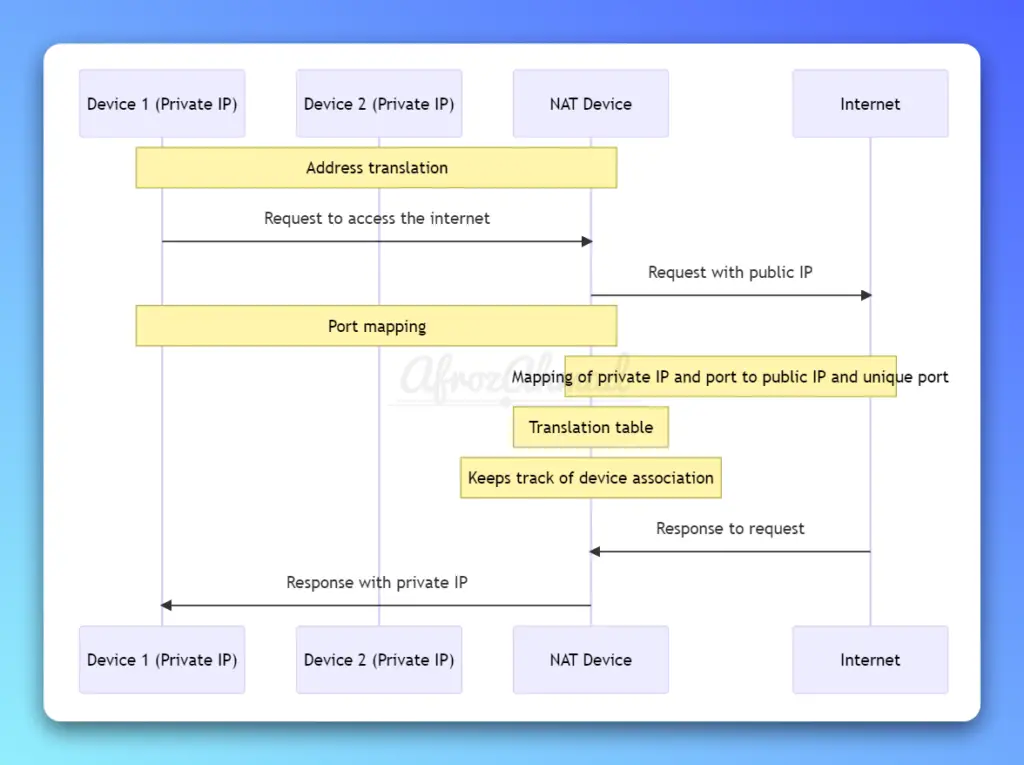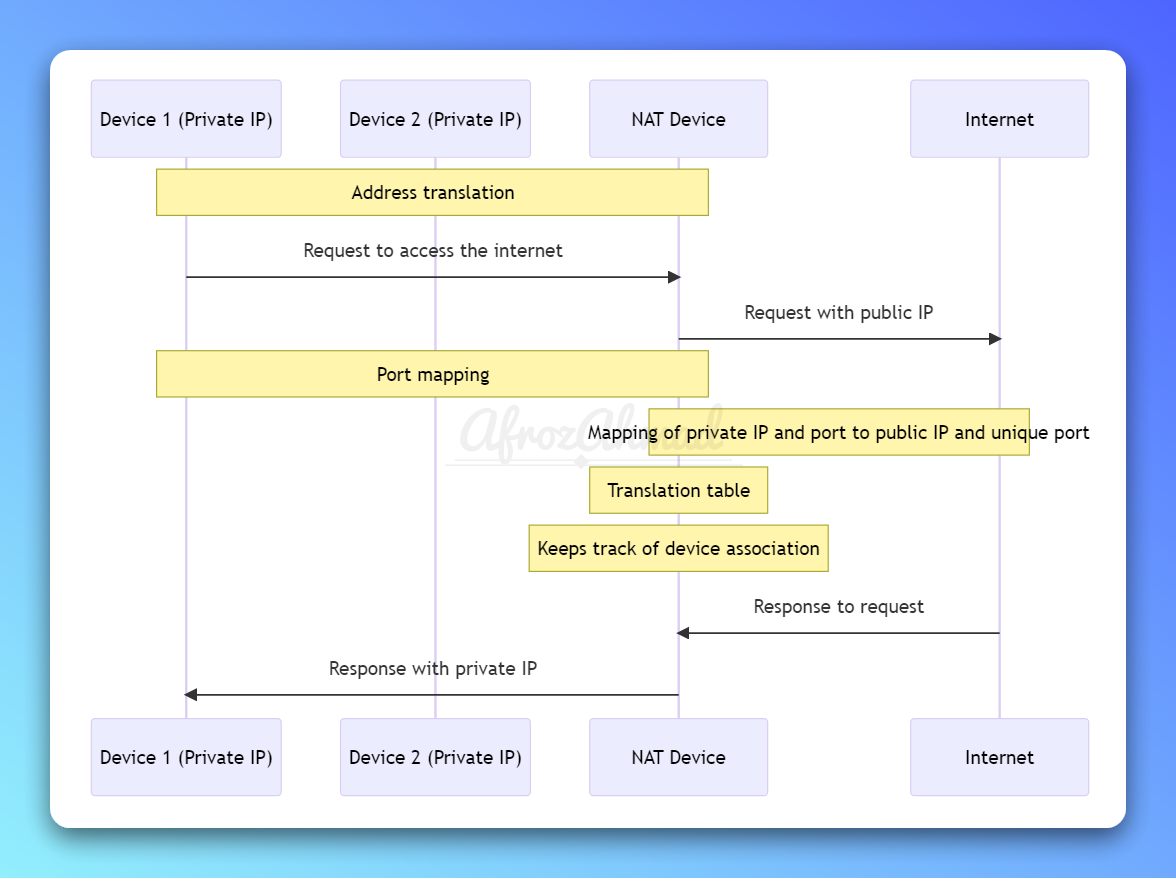NAT is a crucial technology that facilitates communication between devices on a network by translating their private IP addresses into public ones. Whether you’re a networking professional or simply intrigued by the topic, this post will guide you through understanding NAT, its mechanisms, various types, benefits, limitations, and roles in IPv4 and IPv6 networks. Gain a comprehensive knowledge of NAT and its applications in computer networking.
What is NAT?
NAT, or Network Address Translation, is a technique used in computer networking that allows multiple devices (like computers, smartphones, or tablets) within a private network to share a single public IP address when connecting to the internet. This helps to conserve the limited number of public IP addresses available and improve network security.
In simpler terms, NAT acts like a receptionist at a company. When an employee (a device within the private network) wants to communicate with someone outside the company (the internet), the receptionist (NAT) takes the message, sends it out using the company’s main phone number (public IP address), and keeps track of the conversation. When a response comes back, the receptionist knows which employee to deliver the message to. This way, everyone in the company can communicate with the outside world using the same phone number (public IP address), making the communication process more efficient and secure.
Purpose of NAT
Network Address Translation (NAT) is used for several reasons, including:
- IP address conservation: NAT allows multiple devices on a private network to share a single public IP address, significantly reducing the number of public IP addresses required. This is particularly important as IPv4 addresses become increasingly scarce.
- Network security: By translating private IP addresses to a single public IP address, NAT provides a layer of obscurity, making it more difficult for attackers to target individual devices on a network.
- Network topology flexibility: NAT allows network administrators to reconfigure their internal network without the need to change public IP address assignments or update routing information.
How NAT Works
The fundamental mechanisms behind NAT include:
- Address translation: NAT translates private IP addresses into public IP addresses (and vice versa) to facilitate communication between devices on a private network and the public internet.
- Port mapping: NAT maintains a mapping of private IP addresses and port numbers to a single public IP address and unique port numbers. This allows multiple devices to share a single public IP address while maintaining individual connections.
- Translation tables: NAT devices maintain a table of active address translations, enabling them to keep track of which internal device is associated with each external communication session.
Let’s understand the NAT concept by this simple diagram:-

The above diagram is a sequence that illustrates the interaction between devices on a private network, a NAT device, and the Internet. Here’s a step-by-step description of what’s going on in the diagram:
- Two devices with private IP addresses (Device 1 and Device 2) are shown on the left side of the diagram, representing devices within a private network.
- The NAT device is placed in the middle, acting as a mediator between the private network devices and the internet.
- The internet is represented on the right side of the diagram.
The address translation process is denoted by a note over Device 1 and the NAT device:
- Device 1 sends a request to access the internet.
- The NAT device translates Device 1’s private IP address to a public IP address, allowing it to communicate with the internet.
The port mapping process is illustrated by notes over the NAT device and the internet:
- The NAT device maps the private IP address and port of Device 1 to a public IP address and a unique port number. This mapping allows multiple devices on the private network to share the same public IP address while maintaining individual connections.
Lastly, the NAT device maintains a translation table to keep track of the association between devices on the private network and their respective external communication sessions. This is represented by a note over the NAT device in the diagram.
When the internet sends a response to the request, the NAT device receives it, translates the public IP address back to the private IP address of the requesting device (Device 1), and forwards the response accordingly.
Types of NAT

There are different types of NAT, each with its own advantages and disadvantages:
- Static NAT: In Static NAT, a private IP address is mapped to a specific public IP address. This provides a consistent public IP address for a device, making it suitable for services requiring inbound connections, such as web servers. However, it does not efficiently conserve public IP addresses.
- Dynamic NAT: With Dynamic NAT, private IP addresses are mapped to a pool of available public IP addresses. This method is more efficient in conserving public IP addresses but does not provide the consistency required for services that need a fixed public IP address.
- Port Address Translation (PAT): Also known as NAT Overload, PAT maps multiple private IP addresses to a single public IP address using unique port numbers. This is the most efficient method for conserving public IP addresses, but it can introduce complexity and potential performance issues.
NAT in IPv4 and IPv6
NAT plays a vital role in both IPv4 and IPv6 environments. While NAT is widely used in IPv4 networks to address IP address exhaustion, its role in IPv6 networks is evolving. IPv6 provides a vastly expanded address space, reducing the need for address conservation. However, NAT may still be used in IPv6 networks for security and network management purposes.
When translating between IPv6 and IPv4 addresses, NAT64 is used. NAT64 allows IPv6-only networks to connect to IPv4 services.
Benefits and Limitations of NAT
Benefits of using NAT include:
- Enhanced security: NAT provides a layer of obscurity, making it more difficult for attackers to target individual devices on a network.
- Address space preservation: NAT enables multiple devices to share a single public IP address, conserving public IP address resources.
- Reduced network restructuring: Can change private IP addresses without impacting the public network.
Limitations of NAT:
- Potential performance issues: NAT can introduce processing overhead and latency, particularly in high-traffic environments.
- Compatibility concerns: Some applications and protocols may not function correctly when using NAT due to the address translation process.
- Loss of end-to-end connectivity: Obscures the internal network topology.
- Limited port numbers(up to 65,535): You might (although it is highly unlikely) run out of ports for mapping multiple IP addresses to a single public IP address.
Real-world Examples
- Home networks: Most home routers use NAT to enable multiple devices (computers, smartphones, tablets, etc.) to connect to the internet using a single public IP address provided by the internet service provider (ISP).
- Small business networks: NAT is commonly used in small business environments where a limited number of public IP addresses are available. NAT allows the business to efficiently use these IP addresses while maintaining connectivity for all devices on the network.
- Large organizations: In large organizations, NAT is often deployed in combination with Virtual Private Networks (VPNs) and firewalls. This provides both security and efficient use of public IP addresses while maintaining connectivity for a large number of devices.
- Data centers: In data center environments, NAT may be employed for load balancing and ensuring the high availability of services. By translating IP addresses, NAT can distribute incoming traffic among multiple servers, providing redundancy and improving overall performance.
Conclusion
Network Address Translation (NAT) is an essential technology in modern computer networking that allows devices on a private network to communicate with the public internet using a limited number of public IP addresses. Through its various types, such as Static NAT, Dynamic NAT, and Port Address Translation (PAT), NAT provides IP address conservation, network security, and network topology flexibility.
While NAT is indispensable in IPv4 networks, its role in IPv6 networks is evolving due to the vastly expanded address space. Despite some limitations, such as potential performance issues and compatibility concerns, NAT remains a vital component in various networking scenarios, from home networks to large-scale data centers.
We hope this article has provided you with a comprehensive understanding of NAT and its importance in the world of computer networking. We encourage you to explore the topic further and apply this knowledge in your networking endeavors.
- 10 Best Network Switches for Home Networks in 2026 (Top Picks) - December 24, 2025
- 7 Best Budget Routers For Small Business Networks (Under $200) - December 22, 2025
- How to Configure a Secure Site-to-Site VPN on Cisco Firepower Complete Guide - December 3, 2025




